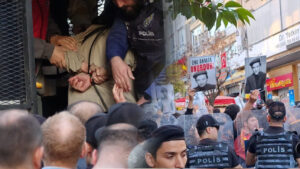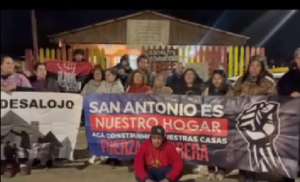
Struggle for land advances in the hinterland of Pernambuco-Paraíba against goons and latifundium
We publish an unofficial translation of an article of the democratic newspaper A Nova Democracia on the advance of the struggle for land in Brazil.
The hinterland between Pernambuco and Paraíba is one of the great stages of the struggle for land in the country. This year, 11 occupations, which mobilized around 5 thousand families, were carried out in Pernambuco during Red April promoted by the Landless Rural Workers Movement (MST). A month earlier, on March 24, 2024, the body of José Roberto da Rocha was found charred near an area of the Orlando Bernardino camp, thus making it the fourth MST activist murdered in the region, in crimes very possibly linked to the big landlords who work for land grabbing and goons in the region.
This violence in the region, typical of an undeclared armed conflict, is not new, and has deep roots that date back to the origins of latifundium and land grabbing in the region. According to Incra geoprocessing data, this region has vast areas in a situation of large self-declared possessions. This entire territory under the impasse of self-declaration creates an environment with all the conditions for the latifundium and their paramilitary groups to invest in the violence characteristic of one of the many aspects of semi-feudality.
It is also possible to notice that most of the territories in the region are characterized by this type of ownership, demonstrating the advancement of land grabbing in the Zona da Mata and that a large part of this land is intended for the monoculture of sugar cane. . This region is dominated by latifundium in its most backward form possible, in the same production mold imported by the European invasion. Being one of the main sugarcane producers in the Northeast and using a system of exploitation of peasant labor characteristic of the most open face of semi-feudality.

These lands in the Zona da Mata of Paraíba and Pernambuco are largely the result of the expansion of the large-scale agricultural frontier (in the vast majority of cases illegally) with the sponsorship or connivance of the old bureaucratic-big landlord State. These are so immense territories that a single latifundium exceeds the size in km² of half of the municipalities in the two States.
Within this entire region, the municipality of Alhandra, in Paraíba, is characteristic of the process, and has in recent years concentrated peasant struggles and goon crimes in camps such as Acampamento Dom José Maria Pires, built on the unproductive latifundium of Garapú Farm.
The origin of latifundium in Alhandra
Violence as a form of domination in the territory of Alhandra, in the Zona da Mata of Paraíba, has its origins in the act of its “foundation”, which was from the Jesuit village of “Arataguy”, with several indigenous ethnic groups kidnapped by the invaders and subjected to the process of acculturation against original peoples, denying them freedom, religiosity, their names, languages, etc.
With the end of the rot in the villages, the territory of Alhandra, categorized by the slave-feudal empire as Vila, had a population predominantly indigenous or descendants of indigenous peoples. Alhandra is also one of the birthplaces of the Afro-indigenous Jurema Sagrada religion, which considers the city as one of the “enchanted portals”.

The Garapú farm dates back to the time of the Brazilian slave-feudal Empire. In 1866, the farm was already evident as one of the largest latifundium in the region, driven by the 1850 land law, while it had (and still has) several quilombola and indigenous territories in its neighborhood, warlike peoples who did not bow down to the exploitation of the large latifundium.

This history of state-sponsored land grabbing at the expense of peasants and indigenous people continues to this day. Originally the 10.2 thousand hectare area of the Garapu farm had been allocated for agrarian reform in the 1970s, but large businessmen and big landlords responsible for the delay, such as the “Grupo João Santos”, from Pernambuco, represented by companies such as Cimentos Nassau and Agrimex (and 45 other large companies) began to invade and grab the agrarian reform lands for bamboo monoculture.
In July 2017, the Landless Rural Workers Movement (MST) began a day of occupations in the municipality of Alhandra with the aim of retaking the lands invaded by latifundium. In one of the first occupied areas, the Dom José Maria Pires Camp was formed. Currently the camp has 350 families struggling for Agrarian Reform.

One year and four months later, the latifundium gave a clear response: Orlando da Silva, leader of the MST in the region, and Rodrigo Celestino, coordinator of the camp, were murdered on December 8, 2018 by hooded and heavily armed goons from the latifundium. All this while Orlando and Rodrigo were having dinner at the camp. Orlando was not the first in his family to be a victim of latifundium. His brother, Odilon Bernardo da Silva, who was a member of the Movement of People Affected by Dams (MAB) was murdered in an ambush in 2009 in the city of Aroeiras (PB).
The modus operandi of the action that killed Orlando and Rodrigo was typical of the goons that operates closely with the Military Police (PM). When the four killers arrived at the camp, late at night, they took several families by surprise and announced that it was a “police operation”.
And as is common in cases like this, the police never resolved the case. At the time, police investigations stated that the motivation was a dispute between MST peasants and construction businessmen who were extracting land in the camp area illegally. After almost seven years the investigation is inconclusive.
There are gaps that are explicit in the process and have not been properly explained. For example, the crime was committed by four hooded men who were not identified. Among those arrested are Rawlinson Bezerra de Lima, identified as the intellectual executor, as well as Maria de Fátima Santos Freitas and Leandro Soares da Silva. To this day, the role of the last two in the murder remains unclear.
The investigations also tried to distort the nature of the crime as something associated with goons and conflicts over land: the Civil Police delegate, Roberta Neiva, even stated that the crime had no connection with the activities of the movement’s militants, that the motivation would have was merely personal between the killers and the movement’s leaders. The statement completely contradicts what family members of MST victims and campers say and only serves to further fuel impunity in favor of those who use violence against those who struggle for land in Brazil.
According to an article by Repórter Brasil, Orlando’s brother and his son report that, before the crime, there was already fear about the murder of their companions and state that the motivation is political, mainly due to the two’s actions in defending the struggle for land.
The case made it clear to the peasants that the goon crimes would not be punished, the message for the large big landlords was the opposite: the crimes of the big landlords could occur freely. And so it was, not just with the murders. In 2021, the MPF filed five complaints against the João Santos Group, but only three years later 26 members of the conglomerate would become defendants on charges of money laundering and criminal organization. It turns out that they were already basically cleared: the Brazilian State signed in 2023 the largest judicial recovery agreement in the history of this old State, with the objective of “regularizing” R$10.7 billion in tax and labor debts.

The increase in violence against peasants in Paraíba and Pernambuco
Another camp, named in honor of Orlando Bernardino, is part of the expansion of land occupations in the State of Paraíba in recent years. The area is a pre-settlement and is also located in Alhandra, in an area close to the camp Dom José Maria Pires.
Against these camps, the reactionary violence of the latifundium is fierce. In addition to the murder of José Roberto da Rocha in March of this year, and of Orlando and Rodrigo in 2018, other goon crimes are accumulating throughout the region. In 2022, peasant Severino Bernardo da Silva, known as Suzy, was tortured and murdered at the Wanderley Caixe Camp, in Pedras de Fogo, neighboring the municipality of Alhandra. At the end of 2023, two activists of the Movement were murdered in Princesa Isabel, a city in the hinterland of Paraíba.
Aldecy Viturino Barros and Ana Paula were making repairs to the roof of a house in the camp when they were shot by two armed men. Days earlier, the murder of peasant Josimar da Silva Pereira had been recorded, in Vitória de Santo Antão, in the Pernambuco forest area, while he was heading to the rice plantation to carry out irrigation work.
Despite attempts at intimidation, the struggle for land advances in the region
Even with the various attempts to intimidate organized peasants in Pernambuco and Paraíba, the struggle for land continues to advance in these states. Since 2017, several unproductive areas in all regions of the States have been occupied by peasants.
The emergence of new camps has been boosted since then. Peasants are not intimidated and have been expanding the struggle for land and confronting latifundium, organizing themselves and looking for ways to protect themselves.
In the early hours of April 19, around 100 peasant families organized by the MST occupied a 500-hectare area owned by Embrapa in Patos, in the high hinterland of Paraíba, one of the 11 occupations that took place in the month in the region associated with Red April.
Meanwhile, the increase in combativeness of peasant organizations operating in the region stands out, a sign of the echoes of calls from organizations such as the League of Poor Peasants, which call on peasants to organize themselves in an increasingly higher level in the fight against gangs of goons and latifundium, as part of the Agrarian Revolution that takes place in the country.

